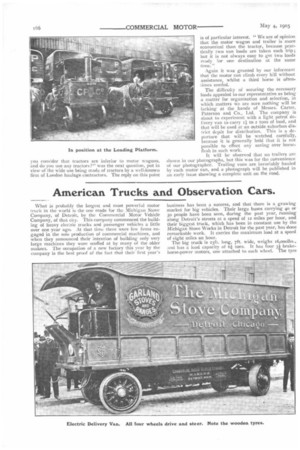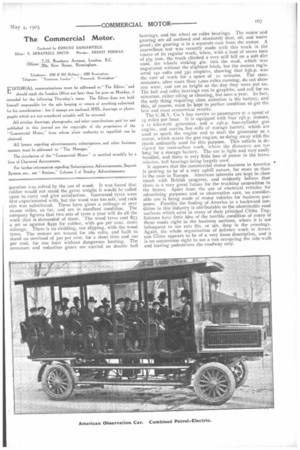American Trucks and Observation Cars.
Page 10

Page 11

If you've noticed an error in this article please click here to report it so we can fix it.
What is probably the largest and most powerful motor truck in the world is the one made for the Michigan Stove Company, of Detroit, by the Commercial Motor Vehicle Company, of that city. This company commenced the building of heavy electric trucks and passenger vehicles a little over one year ago. At that time there were few firms engaged in the sole production of commercial machines, and when they announced their intention of building only very large machines they were scoffed at by many of the older makers. The occupation of a new factory this year by the company is the best proof of the fact that their first year's
business has been a success, and that there is a growing market for big vehicles. Their large buses carrying 40 or 5o people have been seen, during the past year, running along Detroit's streets at a speed of 12 miles per hour, and their biggest truck, which has been in constant use by the Michigan Stove Works in Detroit for the past year, has done remarkable work. It carries the maximum load at a speed of eight miles an hour.
The big truck is 3ft. long, 7ft. wide, weighs 16,000lbs., and has a load capacity of 61 tons. It has four 3i brakehorse-power motors, one attached to each wheel. The tyre
question was solved by the use of wood. It was found that rubber would not stand the great weight it would be called upon to carry and give satisfaction. Gumwood tyres were first experimented with, but the wood was too soft, and rock elm was substituted. These have given a mileage of over to,000 miles, so far, and are in excellent condition. The company figures that two sets of tyres a year will do all the work that is demanded of them. The wood tyres cost $75 .a set as against $450 for rubber, with 400 per cent, more mileage. There is no skidding, nor slipping, with the wood tyres. The motors are wound for 160 volts, and built to stand an overload of 5o0 per cent, for a short time and loo per cent, for one hour without dangerous heating. The armature and reduction gears are carried on double ball bearings, and the wheel on roller bearings. The motor and gearing are all enclosed and absolutely dust, oil, and water proof ; the gearing is in a separate case from the motor. A marvellous test was recently made with this truck in the course of its regular work, when, with a load of seven tons of pig iron, the truck climbed a very stiff hill on a soft dirt road, the wheels sinking 41n. into the mud, which was negotiated without the slightest hitch, but the meters registered 140 volts and 350 amperes, showing that 6511.p. was the rate of work for a space of to minutes. The commutators, after more than t,000 miles running, do not show any wear, and are as bright as the day they were put on. The ball and roller bearings run in graphite, and call for no attention, either oiling or cleaning, but once a year. In fact, the only thing requiring close attention is the battery, and this, of course, must be kept in perfect condition to get the best and most economical results.
The C.M.V. Co.'s bus carries 20 passengers at a speed of is miles per hour. It is equipped with four .2-01.p. motors, a 12 kilo-watt generator, and a 25h.p. four-cylinder gas engine, and carries five cells of storage battery, which are used to spark the engine and to start the generator as a motor, which starts the gas engine, so doing away with the crank ordinarily used for this purpose. This vehicle is designed for inter-urban work, where the distances are too long for a storage battery. The car is light and very easily handled, and there is very little loss of power in the transmission, ball bearings being largely used. It appears that the commercial motor business in America ls proving to be of a very uphill nature, far more so than is the case in Europe. American interests are kept in close touch with British progress, and evidently believe that there is a very great future for the trucking proposition in the States. Apart from the use of electrical vehicles for advertising purposes and as observation cars, no considerable use is being made of motor vehicles for business purposes. Possibly the finding of America in a backward condition in this industry is attributable to the abominable road surfaces which exist in many of their principal Cities. Englishmen have little idea of the terrible condition of many of these roads right in the business sections, where it is not infrequent to see ruts Sin, or gin. deep in the crossings. Again, the whole organisation of delivery work in American Cities appears to be of a very loose description, and it is no uncommon sight to see a van occupying the side walk and leaving pedestrians the roadway only.
















